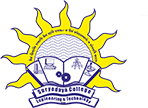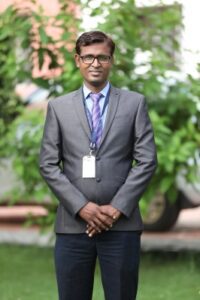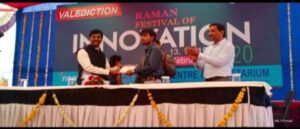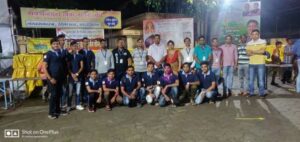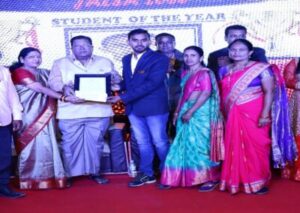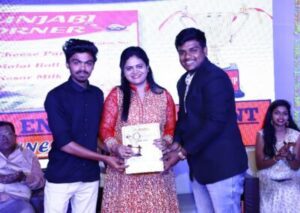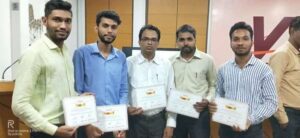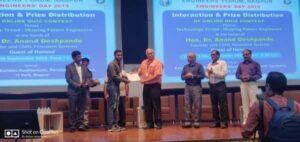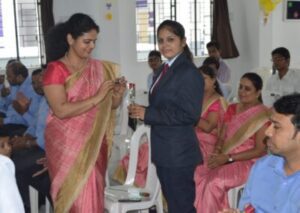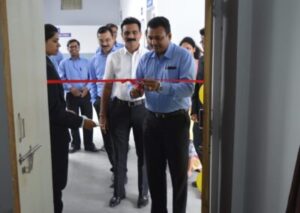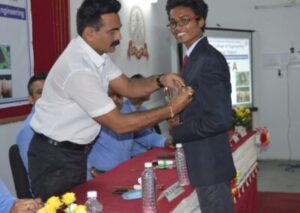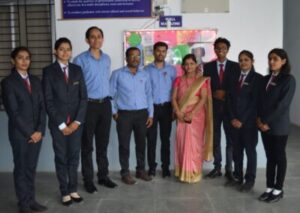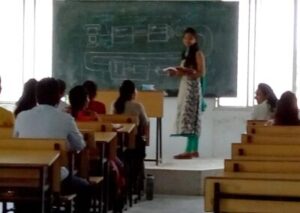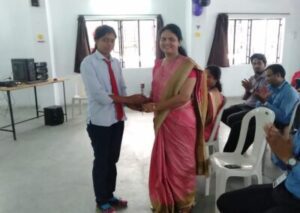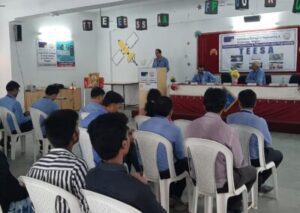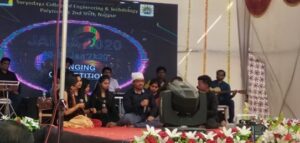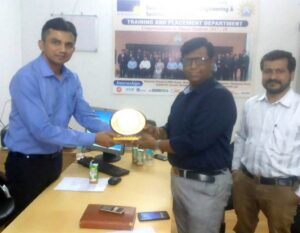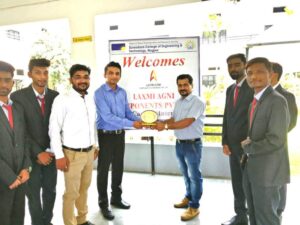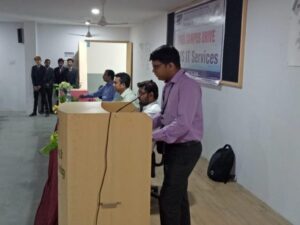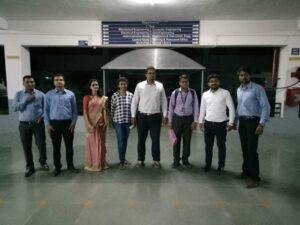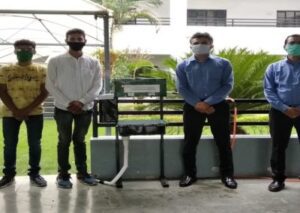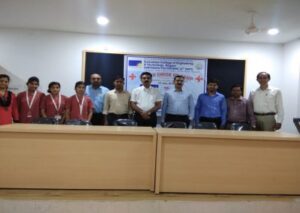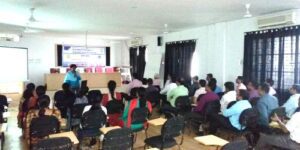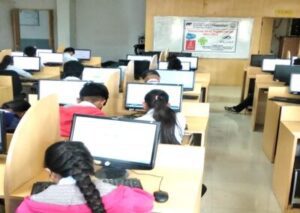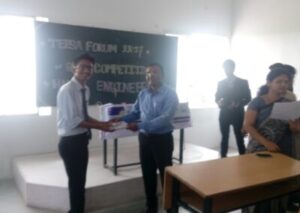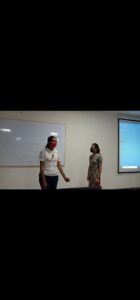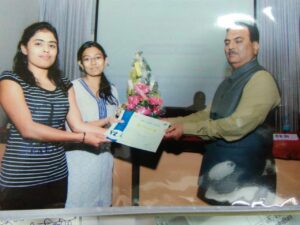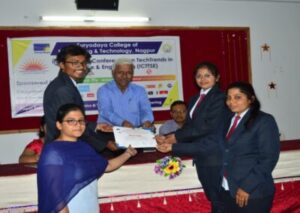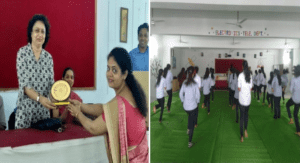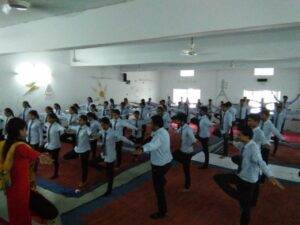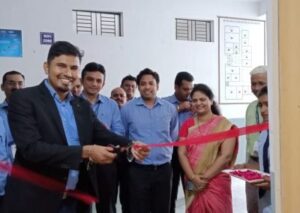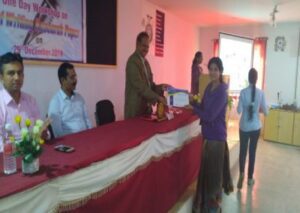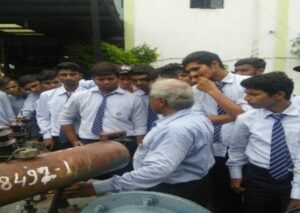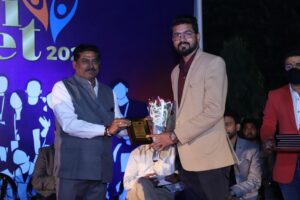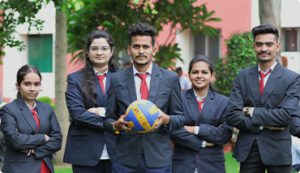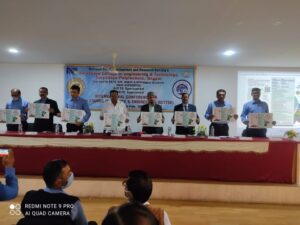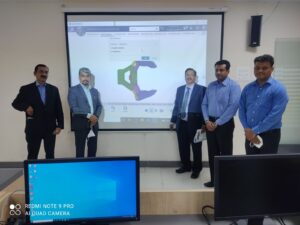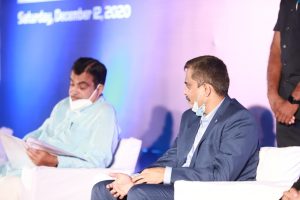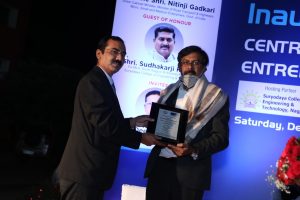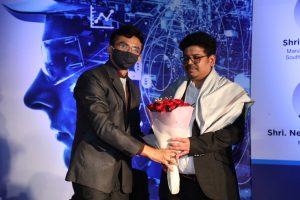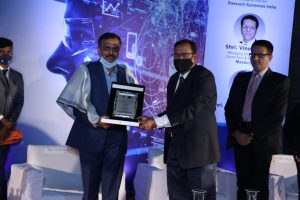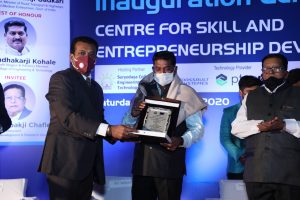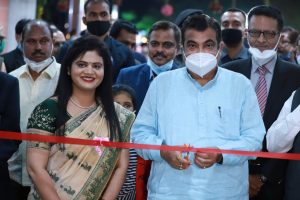| COURSE OBJECTIVES |
COURSE OUTCOMES |
SYLLABYS |
| THIRD SEMESTER B.E. |
|
| BEELE301T :- APPLIED MATHEMATICS-III |
Scheme (Theory: 4 hrs, Tutorial: 1hr.)
UNIT – I: LAPLACE TRANSFORM (15Hrs)
Definition, Properties, Evaluation of integrals by Laplace Transform, Inverse Laplace Transform and its Properties, Convolution theorem (statement only), Laplace Transform of Periodic Functions (statement only), Unit Step Function and Unit Impulse Function, Applications of Laplace Transform to solve Ordinary Differential Equations, Simultaneous Differential Equations, Integral Equations & Integro-Differential Equations.
UNIT – II: FOURIER SERIES & FOURIER TRANSFORM (08 Hrs)
Periodic functions and their Fourier Expansions, Even and Odd functions, Change of interval, Half Range Expansions.
Fourier Transform: Definition and Properties (excluding FFT), Fourier Integral Theorem, Relation with Laplace Transform, Applications of Fourier Transform to Solve Integral Equation.
UNIT – III: CALCULUS OF VARIATIONS(05 Hrs)
Functionals, Maxima and minima of functionals, Euler‟s equation(statement only), Functionals dependent on First & Second order derivatives, Isoperimetric Problems, Solution of Boundary Value problems by Rayleigh-Ritz method.
UNIT- IV: FUNCTIONS OF COMPLEX VARIABLE (12 Hrs)
Analytic function, Cauchy- Riemann Conditions, Harmonic Functions (excluding orthogonal system), Milne-Thomson Method, Cauchy Integral Theorem & Integral Formula (Statement only), Taylor‟s & Laurent‟s series (Statement only), Zeros and Singularities of Analytic function, Residue Theorem (Statement only), Contour integration (Evaluation of real definite integral around unit circle and semi-circle).
UNIT – V: PARTIAL DIFFERENTIAL EQUATIONS(08Hrs)
Partial Differential Equations of First Order First Degree i.e. Lagrange‟s form, Linear Homogeneous Equations of higher order with constant coefficients. Method of separations of variables, Simple Applications of Laplace Transform to solve Partial Differential Equations (One dimensional only). UNIT –VI: MATRICES(12Hrs)
Linear and Orthogonal Transformations, Linear dependence of vectors, Characteristics equation, Eigen values and Eigen vectors, Statement and Verification of Cayley Hamilton Theorem [without proof], Reduction to Diagonal form, Reduction of Quadratic form to Canonical form by Orthogonal transformation, Sylvester‟s theorem [without proof],
Solution of Second Order Linear Differential Equation with Constant Coefficients by Matrix method. |
| The course objective is to impart knowledge of Laplace Transformation, differential equations, partial Differential equation and MATRICES |
After studying this subject, the students will be able to: |
| C301.1 Understand the properties of Laplace change tackle different building Problems. |
| C301.2 Competent to work out the Fourier arrangement portrayal of an occasional capacity and to unravel fractional differential conditions. |
| C301.3 Find the outrageous estimations of useful’s utilizing Euler’s condition. |
| C301.4 Understand expository capacity of a perplexing variable and to apply Cauchy vital hypothesis and buildup hypothesis to unravel shape reconciliations. |
| C301.5 To comprehend customary differential conditions with steady coefficients and apply the strategy for detachment of factors to tackle Partial differential conditions. |
| |
C301.6 Apply idea identified with network variable based math for illuminating straight differential conditions and other building issues. |
| |
|
| BEELE302T :- NON CONVENTIONAL ENERGY SOURCES |
UNIT-I
Solar Radiation & its Measurement: Solar Constant, Solar radiation at earth’s surface, solar radiation geometry, solar radiation measurement, estimation of average solar radiation, solar radiation on tilted surfaces.
UNIT -II
Solar Energy Collectors: Physical Principles of the conversion of solar radiation into heat,flat plate collectors, transitivity of cover systems, energy balance equation and collector efficiency, concentrating collectors, comparison of concentrating and flat plate collectors, selective absorber coatings.
Solar Energy Storage : Solar Energy Storage system (Thermal, Electrical, Chemical, Mechanical), Solar ponds.
UNIT-III
Application of Solar Energy: Solar water heating, space heating, space cooling, solar thermal heat conversion, solar photovoltaic energy conversion, solar pumping, solar cooking, online grid connected solar photovoltaic generation system.
UNIT – IV
WIND ENERGY: Basic principles of wind energy conversion, wind energy conversion system, wind data & energy estimation, site selection consideration, basic components of wind energy conversion system (WECS), classification of WEC system, generating system, energy storage, application of wind energy.
UNIT-V
ENERGY from OCEANS: Ocean thermal electric conversation (OTEC), Claude & Anderson cycles, evaporators, Bio-fouling, Hybrid cycle, components of OTEC for power generation.
Energy from Tides: Introduction, basic principles of Tidal power, components of Tidal Power Plants, operation methods of utilization of Tidal Energy; Estimation of Energy & Power in simple single basin Tidal system, Advantages & limitations of Tidal Power Generations, energy & power from wares, wave energy conversions devices.
UNIT- VI
OTHER NONCONVENTIONAI, ENERGY SOURCE: Brief Introduction to operating principles only): small scale hydro electric power generation, Energy from Bio –Mass, Geothermal Energy, MHD power generation, fuel cell etc. |
| Students will introduce with various sources of Non-conventional energy such as solar wind, small hydro ocean & wave energy. |
After studying this subject, the students will be able to: |
| C302.1 Learn basics of Solar radiation and estimation. |
| C302.2 Understand head of sun based vitality gatherers and capacity frameworks. |
| C302.3 Learn different utilizations of sunlight based vitality. |
| C302.4 Perform determination of locales for wind ranch and various sorts of wind generators. |
| C302.5 Understand essential of little hydra, sea, and wave vitality and other non-conventional Energy sources. |
| |
|
| BEELE303T :- ELECTRICAL MEASUREMENT AND INSTRUMENTATION |
Unit 1: Measurement of RLC Elements:- Loading effect of instruments, Measurement of Resistance: classification, measurements by voltage drop
method, Measurement of medium resistance :- Wheatstone Bridge. Low resistance: – Kelvin‟s Double Bridge. High resistance: – Ohmmeter, Megger & loss of charge method. Earth resistance: – Earth tester,
Measurement of inductance using Maxwell‟s inductance-capacitance bridge, Measurement of Capacitance using Schering‟s & Hays bridge, LCR meter.
Unit 2: Analog Instruments : Principle & operation of moving iron, PMMC and dynamometer type instruments. Special Instruments : Power factor meter, frequency meter, synchronoscope.
Unit 3: Measurement of Power & Energy: True RMS Measurement, Principle of Measurement of active, reactive and apparent power in polyphase circuits. Measurement of Energy in single and polyphase circuits. General theory & extension of range using C.T. & P.T., errors in instrument transformers, applications of instrument transformers for metering.
Unit 4: Generalised instrumentation systems :- Active and passive transducers, Digital and analogue mode of operation, Static and Dynamic characteristics and performance of instruments. combination of errors. Introduction to Data Acquisition Systems. Elementary Idea of Microprocessor based instrumentation.
Unit 5: Measurement of Force Torque, Velocity & Acceleration: Different types of load cells – strain gauge load cell, Different methods of torque measurement,–stroboscope. Accelerometers – LVDT, piezo-electric strain gauge and variable reluctance type accelerometers – mechanical type vibration instruments – seismic instrument as an accelerometer and vibrometer
Unit 6: Temperature, Pressure and Flow measurement:- Bimetallic thermometers – Electrical methods of temperature measurement, Resistance Temperature Dedectors (RTD) and their characteristics, thermistor, Thermocouples, law of thermocouple, special techniques for measuring high temperature using thermocouples. Units of pressure, Bourdon type bellows, Diaphragms, Electrical methods, elastic elements with LVDT and strain gauges, capacitive type pressure gauge, piezo resistive pressure sensor, measurement of vacuum, McLeod gauge, thermal conductivity gauges, Ionization gauge, Introduction to flow meters, types and principles, Orifice plate, Venturi tube. Different types of ultrasonic flow meters, pitot tube, electromagnetic flow meter, hot wire anemometer. |
| Students will learn the details of different electrical instrument used for electrical measurement and Instrumentation, different types of Bridges & different types of potentiometers, CT and PT, various transducers, analog to digital conversions, data acquisition. |
After studying this subject, the students will be able to: |
| C303.1 Understand the details of different bridges utilized for estimation of RLC |
| C303.2 Understand the details of various electrical estimating instruments. |
| C303.3 Measure the electrical force and vitality and utilization of CT, PT |
| C303.4 Study the generalized instrumentation system with the help of a block diagram |
| C303.5 Know the transducers and its utilization for estimation of force, torque, velocity, acceleration.. |
| C303.6 Understand the basic idea about measurement of temperature, pressure & flow measurement |
| |
|
| BEELE304T :- NETWORK ANALYSIS |
UNIT –1
Voltage current sources, source transformation mosh basis equilibrium equation, matrix approach For complicated network containing independent sources and reactances.
UNIT-2
Nodal basis equilibrium equation matrix for electrical network containing independent sources And reactances, Duality
UNIT-3
NETWORK THEOREM: Superposition, Reciprocity, Thevenin‟s, Norton‟s, maximum power transfer, compensation, Tellegen‟s theorem as applied to A.C. & DC circuits.
UNIT-4
Laplace transform and properties, partial fractions, singularity functions, waveforms, synthesis. Analysis of RC, RL and RLC network with and without initial conditions with Laplace transforms, evaluation of initial condition.
UNIT-5
Transient behaviors concept of complex frequency, Driving points and transfer functions,poles, zeros Of transfer function, their properties.
UNIT-6
Two port network parameters and inter connections, study of series and parallel resonance in a.c. Three phase balanced and unbalanced circuit and power calculations |
| The course objective is to impart knowledge of |
After studying this subject, the students will be able to: |
| Behavior of basic circuit elements. |
C304.1 Apply the information on source change and kirchoff’s voltage on electrical systems. |
| Fundamental concepts and methods used for analysis of dc, single-phase and three-phase circuits |
C304.2 Apply the information on kirchoff’s law for analysis of electrical circuits and change of circuit using duality. |
| various mathematical tools/transformations used in circuit analysis |
C304.3Applyvariousnetworkstheoremforanalysisofelectricalcircuits. |
| |
C304.4EvaluatetheinitialconditionsusingknowledgeofLaplacetransformationandanalysisofvariouswaveforms. |
| |
C304.5KnowtheTwoPortnetwork. |
| |
C304.6ApplytheknowledgeofresonanceforseriesandparallelRLCcircuitandcalculationofvariouselectricalquantitiesfor3phasecircuits. |
| |
|
| BEELE305T :- ELECTRONIC DEVICES & CIRCUITS |
Unit 1: Theory of PN-junction diodes, operation and characteristics, Zener diodes and voltage regulators, Half and Full Wave Rectifiers, Filters, Ripple factor, Voltage doublers.
Unit 2: BJT, Theory of operation, characteristics, Biasing arrangements, Stability factor,Small signal analysis of CE, CB, CC amplifiers and their comparison, Power Transistors, Transistor as a switch.
Unit 3: Power amplifiers- classification as A,B, AB, C, Push pull amplifiers, Cross over distortion, Positive and Negative amplifiers- classification, feedback amplifiers, advantages and applications.
Unit 4: Oscillators- Barkhausen‟s criterion, RC and Crystal oscillators. Field effect transistors and MOSFETs- Principle of operation and characteristics, biasing arrangements.
Unit 5: Differential amplifier circuits and their stages, current source, biasing, level Shifting techniques, Common mode and differential mode gain, Impedance of different stages.
Unit 6: Boolean Identities, Binary, Gray, Octal, Hex & ASCII, Codes, Logic gates and their truth tables, De Morgan‟s Laws, Concept of Sum of Products and Product of Sums. |
| The course objective is to impart knowledge of basic semiconductor devices, transistors, amplifiers, FET & MOSFETS. Students also learn digital circuits with Boolean Algebra, logic gates etc. |
After studying this subject, the students will be able to: |
| C305.1Principle and working of basic semiconductor devices, transistors, amplifiers, FET & MOSFETS. |
| C305.2Conversion of numbers from one code to other code. |
| C305.3Logic gates and truth tables of digital circuits. |
| |
|
| FOURTH SEMESTER B.E. |
|
| BEELE401T :- APPLIED MATHEMATICS-IV |
UNIT–I : MATHEMATICAL MODELING AND TRANSFER FUNCTION
(12 Hrs)
Mathematical Modeling of physical systems and Differential equations (Mechanical systems, basic translational and rotational systems, basic R-L-C series and parallel circuits), Concept of transfer function, Transfer function for elementary R-L-C circuits,
Elementary block diagram single input single output closed loop system and its reduction. Laplace transform of step, ramp & parabolic signals, Time response of first order systems and second order systems for unit step input, Concept of characteristic
equation q(s) = 0 vs time response.
UNIT – II: Z-TRANSFORM (10Hrs)
Definition , Convergence of Z-transform and Properties, Inverse Z-transform by Partial Fraction Method, Residue Method (Inversion Integral Method) and Power Series Expansion, Convolution of two sequences. Solutions of Difference Equations with Constant Coefficients by Z- transform.
UNIT – III: FUZZY SETS AND FUZZY LOGIC(12 Hrs)
Fuzzy sets and systems, Crisp sets, Overview of Fuzzy logic and classical logic, Fuzzy compliment, fuzzy union and intersection and combinations of these Fuzzy sets operation, Crisp and Fuzzy relations.
UNIT – IV: NUMERICAL METHODS (08 Hrs)
Error Analysis, Solution of Algebraic and Transcendental Equations: Method of False position, Newton –Raphson method and their convergence, Solution of system of simultaneous linear equations: Gauss elimination method, Crout‟s method and GaussSeidel method
UNIT – V: NUMERICAL METHODS (08 Hrs)
Numerical solution of ordinary differential equations :Taylor’s series method, RungeKutta 4th order method, Euler‟s modified method. Milne’s Predictor- Corrector method,
Solution Of Second Order Differential Equations and Simultaneous Differential
Equations by Runge- Kutta method.
UNIT – VI: THEORY OF PROBABILITY (10 Hrs)
Axioms of Probability, Conditional Probability, Baye‟s Rule, Random variables: Discrete and Continuous random variables, Probability function and Distribution function, Mathematical Expectation, Functions of random variable, Variance & Standard Deviation, Moments, Moment generating function, Measures of central tendency and Dispersion, Skewness and Kurtosis. Binomial distribution, Poisson distribution, Normal distribution. |
| The course objective is to impart knowledge of Mathematical Modeling of linear systems, Z-Transform, Fuzzy logic, Numerical Methods and probability theory properties |
After studying this subject, the students will be able to: |
| C401.1 Understand Mathematical Modeling of linear systems and study the control system components specifications through classical and state variable approach. |
| C401.2 Find the Z- Transform, inverse Z- Transforms of a sequence, identify its region of convergence and develop an ability to solve problems in various branches of Engineering. |
| C401.3 Understand the fuzzy sets and fuzzy logic and know the application of fuzzy logic. |
| C401.4 Ability to understand numerical method to solve algebraic, transcendental and system of simultaneous linear equation. |
| C401.5 Apply the knowledge of Numerical Methods to solve ordinary differential equations of first order and first degree and Boundary value problems. |
| C401.6 Prepare to understand Probability Theory properties to analyze and evaluate the problems under consideration. |
| |
| BEELE402T :- ELEMENTS OF ELECTROMAGNETICS |
UNIT-1: VECTOR ANALYSIS : Idea of vector & scalars, Vector Algebra, vector addition, vector subtraction, dot product, scalar product in Cartesian coordinates system, conversion of variables from Cartesian to cylindrical system and vice versa. Spherical co-ordinate system, transformation of Cartesian to spherical and vice versa.
UNIT-2:
Coulomb‟s law, Electrical field intensity and electric, flux density: Coulomb‟s law, electric field intensity, field of „n‟ point charges, field due to continuous volume charge distribution, field of line charge, filed of sheet charges, concept of flux density.
UNIT-3:
Gauss‟s law, Energy and potential of charge system : Gauss‟s law, application of gauss law, divergence theorem, definition of potential difference and potential, potential of a point charges, potential field of system of charge, potential gradient, Energy density in Electrostatic field.
UNIT-4:
Conductors, Dielectric and Capacitance and poison‟s and Laplace Equations : current and current density, continuity of current, metallic conductors, conductor properties and Boundary conditions, Nature of Dielectric materials capacitance and capacitances, Capacitance of parallel plate capacitor, capacitance of two wire line, poisons and Laplace Equation.
UNIT-5:
The steady Magnetic Field and Magnetic forces: Biot Savarts law, Ampere‟s Circuital law, Strokes theorem, magnetic flux density, scalar and vector magnetic potentials, force on moving charge, force between differential current elements nature of magnetic material. Magnetization and permeability, magnetic circuits, potential energy and forces on magnetic materials, Inductance and mutual inductance.
UNIT-6:
Maxwell‟s equations & boundary conditions. Elementary idea of Electromagnetic waves, uniform plane wave. |
| To become knowledgeable in static electric and magnetic fields. To learn various laws of electromagnetic & electrostatic fields. |
After studying this subject, the students will be able to: |
| C402.1 Understand vector analysis using different coordinate system. |
| C402.2 Study coulomb’s law and able to calculate Electric field intensity, Flux density for difference form of charges. |
| C402.3 Understand and apply Gauss’ law, Divergence theorem and estimation of Potential and Energy thickness in electrostatic field. |
| C402.4 Study Poisson’s and Laplace equation and to calculate capacitance and their boundary condition for Dielectric Materials. |
| C402.5 Study various laws for steady magnetic fields and forces. |
| C402.6 Apply Maxwell’s equation and analysis of uniform plane wave propagation and electromagnetic waves. |
| |
|
| BEELE403T :- DIGITAL AND LINEAR ELECTRONIC CIRCUITS |
Unit 1:
TTL, CMOS Logic Families, Combinational Logic concepts, Decoders, Encoders, Multiplexers, Demultiplexers, Code converters, Karanaugh map Principle.
Unit 2:
Introduction to Flip-flop, Latch, Concept of Clock, Overview of RAM, ROM, EPROM & EEPROM, Master slave Flip-flop and conversion of one type to another.
Unit 3:
Introduction to sequential circuits, Synchronous and Asynchronous Counters, Different module counters with reset/ clear facility, Adders, Subtractors, Concept of ALU.
Unit 4:
Basics of Operational Amplifiers, Ideal and non-ideal OPAMPs, Inverting & non-inverting OPAMPs, Integrators, Differentiators, Summer and Averaging circuits, Instrumentation amplifiers, Grounding & Shielding Problems in opamps
Unit 5:
Precision rectifiers, Constant Current & Constant Voltage sources, Introduction to Active filters, Butterworth 2nd order filter – Design & operation, Clipping, clamping and comparator circuits, Sample & Hold circuits, A/D & D/A converters, Phase locked loops.
Unit 6:
Study of Linear ICs : LM 741, LM 555, LM 339, LM 723, LM 78xx & 79xx series, Astable, monostable and bistable multivibrators using IC LM 555. |
| To introduce the basics of logic families, multiplexers, Flip flops, timers. Students will introduce with operational amplifiers, Linear IC‟s and multivibrators used in digital electronics. |
After studying this subject, the students will be able to: |
| C403.1Understand the basic fundamentals of Logic gates, Flip Flops, Timers |
| C403.2Understand the basic operational amplifier circuits. |
| C403.3Study the Simple linear circuit. |
| C403.4Learn the applications of Operational Amplifier. |
| C403.5Study the linear ICS. |
| |
|
| BEELE404T :- ELECTRICAL MACHINES-I |
UNIT-1
SINGLE PHASE TRANSFORMER :- Transformer phasor diagram, equivalent circuit diagram. Transformer equivalent circuit parameter calculation using O.C. & S.C. test. Polarity test and parallel operation of single phase transformer.
3-PHASE TRANSFORMER: principle and operation of three phase transformer and, O.C. & S.C. test on three phase transformer, determination of equivalent circuit parameters, Regulation, Efficiency, Magnetizing current and harmonics, winding identifications, various connections with vector group.
UNIT-2
Three phase to two conversion, parallel operation of three phase transformer, methods of cooling, back to back test, maintenance of transformer, insulation of transformer.
UNIT-3
D.C. MACHNIES: – Basis principle & operation, Armature reaction & commutation, Compensating winding, interpoles. Type of excitation. Characteristics of shunt series & compound motor and generator speed control of d.c. shunt & series motor, constant horse power & constant torque drive of d.c. motor.
UNIT-4
THREE PHASE INDCTION MOTOR: – Types of induction motor and production of torque. Torque-slip characteristics, No load blocked rotor test, circle diagram, losses, efficiency, double cage motor, operating characteristics & influence of machine parameter on the performance of motor. Induction motor as a induction generator.
UNIT-5
Starting of 3 phase I.M. speed control of I.M. by pole changing, frequency control, rotor resistance by varying supply voltage, braking regenerative braking, plugging, dynamic braking Crawling & cogging.
UNIT-6
SINGLE PHASE I.M.: – Double field revolving and cross field theory split phase motor shaded pole motor, equivalent circuit, Torque-slip characteristics. |
| Student will learn The basic principle of transfer of electrical power, operation, construction of 3-phase transformers, their classification, connections and phasor diagrams. The basic principle, construction, operation, performance characteristics, steady state analysis and applications of electrical motors and induction generator. |
After studying this subject, the students will be able to: |
| C404.1 Understand the characteristics and working of 1-Phase and 3-phase transformer to find the equivalent circuit parameters, Regulation, Efficiency and vector grouping of 3-phase transformer. |
| C404.2 Study the Conversion of 3-phase to 2- phase supply, parallel operation and maintenance of 3-phase transformer. |
| C404.3 Understand the Construction, working , features of dc machines and speed control of DC motor and determine its losses and efficiency.. |
| C404.4 Understand the Construction, working , features of 3 Ph Induction motor and its testing to computation of equivalent circuit parameters.. |
| C404.5 Study the Starting, Breaking and speed control of three phase induction motor and find its power losses to calculate efficiency. |
| C404.6 Understand the Construction and working of double cage induction motor, induction generator, and types of single phase induction motors. |
| |
|
| BEELE405T :- COMPUTER PROGRAMMING |
Unit-I: Structure of „C‟ program, Data types, Variables, Input/output statements, Storage class, operators, Program control statements, Concept of function & Recursion.
Unit-II: Arrays, Searching (Linear & Binary), Sorting (Bubble & Selection).
Unit III: Structure(Arrays of Structures, Copying elements of one structure into another, Nested Structure, Structure Pointer)Pointer, File Handling(File open, close, read , write, Copy).
Unit IV: Introduction to C++ concepts.
Unit-V: Introduction to MATLAB Programming
Import/export data, Program and run simple scripts (M-files), Use graphics tools to display data, Conditional Statements (If-else, if-elseif), and Iterative statements (While, For loop).
Unit -VI: Matrix operation (Transpose, determinant, Inverse), Plotting of graphs (Basic plot, generating waveforms) using Matlab Programming. Manipulating text (Writing to a text file, Reading from a text file, Randomising and sorting a list, Searching a list), Programming using MATLAB functions. |
| The student will learn the concept of programming and topics using C & C++ language and apply it in the field of engineering and technology. Similarly student will know about the Matrix operation and use of graphic tools for representation. |
After studying this subject, the students will be able to: |
| C405.1 Learn the essential of C programming. |
| C405.2 Use C language for programming, arrays, searching and sorting techniques. |
| C405.3 Learn the utilization of pointers and structures. |
| C405.4 Understand the fundamentals of C++ |
| C405.5 Study the essential of MATLAB and apply key information for analysis of basic engineering problems. |
| |
|
| BEELE406T :- ENVIRONMENTAL STUDIES |
Unit 1 : Multidisciplinary nature of environmental studies – Definition, scope and importance Need for public awareness.
Unit 2 : Natural Resources : – Renewable and non-renewable resources :
Natural resources and associated problems.
a) Forest resources : Use and over-exploitation, deforestation, case studies. Timber extraction, mining, dams and their effects on forest and tribal people. b) Water resources : Use and over-utilization of surface and ground water, floods, drought, conflicts over water, dams-benefits and problems. c) Mineral resources : Use and exploitation, environmental effects of extracting and using mineral resources, case studies. d) Food resources : World food problems, changes caused by agriculture and overgrazing, effects of modern agriculture, fertilizer-pesticide problems, water logging, salinity, case studies. e) Energy resources : Growing energy needs, renewable and non renewable, energy sources, use of alternate energy sources. Case studies. f) Land resources : Land as a resource, land degradation, man induced landslides, soil erosion and desertification. Role of an individual in conservation of natural resources. Equitable use of resoureces for sustainable lifestyles.
Unit 3 : Ecosystems
Concept of an ecosystem., Structure and function of an ecosystem., Producers, consumers and decomposers., Energy flow in the ecosystem., Ecological succession., Food chains, food webs and ecological pyramids. Introduction, types, characteristic features, structure and function of the following ecosystem :-
a. Forest ecosystem, b. Grassland ecosystem, c. Desert ecosystem, d. Aquatic ecosystems (ponds, streams, lakes, rivers, oceans, estuaries)
Unit 4 : Biodiversity and its conservation
• Introduction – Definition : genetic, species and ecosystem diversity.• Biogeographical classification of India • Value of biodiversity : consumptive use, productive use, social, ethical, aesthetic and option values • Biodiversity at global, National and local levels. • Inida as a mega-diversity nation • Hot-sports of biodiversity. • Threats to biodiversity : habitat loss, poaching of wildlife, man-wildlife conflicts. • Endangered and endemic species of India • Conservation of biodiversity : In-situ and Ex-situ conservation of biodiversity.
Unit 5 : Environmental Pollution
Definition
• Cause, effects and control measures of :-
a. Air pollution, b. Water pollution, c. Soil pollution, d. Marine pollution
e. Noise pollution, f. Thermal pollution, g. Nuclear hazards
• Solid waste Management : Causes, effects and control measures of urban and industrial wastes. • Role of an individual in prevention of pollution. • Pollution case studies. • Diaster management : floods, earthquake, cyclone and landslides. (8 lectures)
Unit 6 : Social Issues and the Environment
• From Unsustainable to Sustainable development • Urban problems related to energy • Water conservation, rain water harvesting, watershed management • Resettlement and rahabilitation of people; its problems and concerns. Case Studies
• Environmental ethics : Issues and possible solutions. • Climate change, global warming, acid rain, ozone layer depletion, nuclear
accidents and holocaust. Case Studies. • Wasteland reclamation. • Consumerism and waste products. • Environment Protection Act.
• Air (Prevention and Control of Pollution) Act. • Water (Prevention and control of Pollution) Act • Wildlife Protection Act
• Forest Conservation Act • Issues involved in enforcement of environmental legislation. • Public awareness.
Unit 7 : Human Population and the Environment
• Population growth, variation among nations. • Population explosion – Family Welfare Programme. • Environment and human health. • Human Rights. • Value Education. • HIV/AIDS. • Women and Child Welfare. • Role of Information Technology in Environment and human health. • Case Studies.
Unit 8 : Field work
• Visit to a local area to document environmental assetsriver/forest/grassland/hill/mountain • Visit to a local polluted site-Urban/Rural/Industrial/Agricultural • Study of common plants, insects, birds. • Study of simple ecosystems-pond, river, hill slopes, etc. |
| Student will be able to learn the natural sources available. Students will also learn about ecosystem, biodiversity, pollution. Student will also learn the effect on environment on social aspects and Human population. |
After studying this subject, the students will be able to: |
| C406.1Understand the ecosystem. |
| C406.2Understand Environmental issues related with social and human population. |
| C406.3Understand Biodiversity and its conversion. |
| |
|
| FIFTH SEMESTER B.E. |
|
| BEELE501T :- ELECTRICAL POWER SYSTEM – I |
UNIT- 1:
Structure of electrical power system, brief exposure to generation, transmission and distribution aspects, elementary
consideration of economic bulk power supply system, use of high voltage general system consideration, idea about
substation, concept of real, reactive and complex power. Load and their characteristics, voltage and frequency
dependence of loads. (10hrs)
UNIT- 2:
Representation of power system elements, models and parameters of generator, transformer and transmission lines,
Transmission line parameters calculation (R,L,C), per unit system representation. 8hrs
UNIT-3:
Elementary distribution scheme: Feeders and distributors. LT and HT cables, Introduction to distribution
automation.
Concept of insulator, types of insulator, string efficiency. 10 hrs
UNIT-4:
Voltage regulation and efficiency of power transmission lines using equivalent pi and T representation.
Representation using circle diagram with generalized constants. 10 hrs
UNIT-5:
Interconnection of system elements to form two bus systems. Illustration of active and reactive power transmission,
types of buses. Introduction to load flow studies in multibus system (Methods of solution not expected). Introduction
of frequency and voltage as system state indicators. 10 hrs
UNIT-6:
Elementary concepts of real and reactive power control. Steady state performance of turbine governors, load sharing
between generators, preliminary concepts of automatic voltage regulator, |
| Students will develop the ability |
After studying this subject, the students will be able to: |
| To model and represent the system components used in power system. |
C501.1 Understand basics of Power System. |
| To represent and understand the transmission line parameters |
C501.2 Model and represent the system components used in power system. |
| To understand the load flow analysis of power system |
C501.3 Understand utilization of cables in distribution network. |
| |
C501.4 Understand the Concept of structuring transmission line boundaries. |
| |
C501.5 Understand the fundamental idea of load flow analysis. |
| |
C501.6 Analyze performance of generators & turbines. |
| |
|
| BEELE502T :- UTILIZATION OF ELECTRIC ENERGY |
Unit I: Electric Heating: (8 Hrs) -i) Electric Heating : Types and methods of electrical heating, advantages of electrically produced heat, types & application of electric heating equipments, transfer of heat. ii) Resistance Ovens : General constructions, design of heating elements, efficiency & losses, radiant heating. iii) Induction heating: Core type & core less induction furnace, indirect induction oven, medium and high frequency eddy – current heating. iv) Dielectric heating: Principle and application. v) Arc furnace : Direct & indirect arc furnace, power supply, characteristics & control.
Unit II: Electric Welding: (8 Hrs) -i) Importance, Advantages & Disadvantages of welding, classification of welding processes. ii) Resistance welding, Butt welding, Spot welding, Projection welding, Seam welding. iii) Electric arc welding: Carbon arc welding, metal arc welding, submerged arc welding, Stainless Steel welding iv) Ultrasonic welding, electron beam welding, laser beam welding.
Unit III : Illumination : (8 Hrs) -Nature of light, terms used in illumination, solid angle, laws of illumination, polar curves, Colour Rendering Index (CRI), Design of illumination systems, indoor lighting systems, factory lighting, outdoor lighting design, flood lighting, street lighting, energy saving in lighting systems.
Unit IV: Refrigeration & Air conditioning: (8 Hrs)- Terminology, refrigeration cycle, refrigeration systems (Vapor compression, vapor absorption), domestic refrigerator, drinking water cooler, desert air cooler. Air conditioning: Factors involved in air conditioning, comfort air conditioning, industrial air conditioning, effective temperature, summer / winter air conditioning systems, types of air conditioning systems, room air conditioning, and central air conditioning.
Unit V: Fans & Pumps: (10 Hrs) – Fans and Blowers: Fan types, fan performance evaluation & efficient system operation, fan design & selection criteria, flow control strategies, fan performance assessment, energy saving opportunities. Pumps: Pump types, system characteristics. Pump curves, factors affecting pump performance, efficient pumping system operation, flow control strategies, energy conservation opportunities in pumping system.
Unit VI: Compressors and DG Sets: (8 Hrs) – Compressors: Compressor types, Compressor efficiency, Compressed air system components. Diesel Generating Systems: Introduction, selection and installation factors, operational factors, energy performance assessment in DG sets, energy saving measures for DG sets.
|
| Students will |
After studying this subject, the students will be able to: |
| understand application of electrical supply for different applications |
C502.1Understand use of electric energy for industrial heating and welding. |
| to calculate electrical equivalent rating for mechanical applications |
C502.2Understand basics of Illumination and design of lighting schemes for Various applications. |
| |
C502.3Understand basics of Refrigeration and Air conditioning system. |
| |
C502.4Understand application of Fans & Pumps. |
| |
C502.5Understand compressors and DG systems and evaluate their performance. |
| |
|
| BEELE503T :- ELECTRICAL MACHINE DESIGN |
Unit. 1:
REVIEW OF MATERIAL USED IN CONSTRUCTION OF ELECTRICAL MACHINES: – Classification of
insulating materials depending upon permissible temperature rise, properties of transformer oil. Standard
specification, C.M.R. and short time rating of machines. Heating and cooling characteristics. (10 Hrs)
Unit. 2:
TRANSFORMER DESIGN: – Specific loading, equation for voltage per turn for power and distribution transformer
output equation. (10Hrs)
Unit. 3:
Principal of electric and magnetic circuit design, method of cooling and cooling circuit design. Estimation of
performance characteristics from the design data. (10 hrs)
Unit. 4:
INDUCTION MOTOR: – Main dimensions, output equation, loading constant estimation of axial lengths, air gap
diameter, winding design. (9 hrs)
Unit. 5:
Air gap length, slot combination for stator and rotor of I.M., cage rotor and wound rotor design.
Calculation of on load current and other performance on characteristics for design data. (8hrs)
Unit. 6:
SYNCHRONOUS MACHINE: Air gap length, methods of obtaining sinusoidal O/P voltage, field coil design for
salient pole machine and for turbo generator rotor, ventilation of synchronous generator, cooling air circuits, closed
ventilation / quantity of cooling medium hydrogen and water as cooling media. (8hrs) |
| Students will develop the ability |
After studying this subject, the students will be able to: |
| To analyze different materials and their properties used in design of machine |
C503.1Select proper material for design of a machine. |
| To calculate and understand the core design and main dimension of transformer |
C503.2Design an overall transformer and estimates its performance characteristics as per requirements and constraints specified. |
| To understand the performance characteristics and cooling of transformers |
C503.3Design rotor core of Induction Motor. |
| |
C503.4Design overall dimensions of synchronous machines. |
| |
|
| BEELE504T :- MICROPROCESSOR & INTERFACING |
UNIT-1:
VLSI circuit concept. Approach to integrated system design using Microprocessors. Bus concepts.
Address, Data and control. Organization of computer with MPU, Bits/ Byts / Words/ Long wards – their
ranges accuracy and precision. Memory organization. Linear / Absolute decoding.
UNIT-2:
Introduction to Intel’s 8085A Architecture description software instructions. Address mode- advantages,
Timing diagrams assess, Assemblers and Dissemblers (By Hand Coding).
UNIT-3:
Flag structure, concept of PSW stacks and subroutines simple and Nested. PUSH, POP instructions and
CALL/RETURN instruction. Stack manipulations, simple programs.
UNIT-4:
Interrupts – Concept and structure in 8085. Interrupt services routines. Advanced instructions and
programming of 8085A.
UNIT-5:
Method of data transfer – serial, parallel, synchronous asynchronous, IN/OUT instructions. Timing
diagrams, simple hardware interface to 8085 of standard Latches/Buffers/Keys/display devices as I/O
ports. Handshaking concept. Architecture and interface of 8255 and 8253 to 8085.
UNIT-6:
Hardware considerations – bus contention. Slow memory interfacing complete signal description of 8085.
Multiplexed Key board/Display interface and assembler directives. General awareness about micro
computer system related products.
|
| This subject helps student to learn the |
After studying this subject, the students will be able to: |
| *Microprocessor applications in electrical engineering. |
C504.1Use and apply VLSI circuit concept. |
| *The principle of microprocessor chip working, programming with microprocessor is also explained in this subject |
C504.2Understand INTEL 8085A architecture. |
| |
C504.3Study the Programming Instructions |
| |
C504.4Understand Interrupts |
| |
C504.5Learn the Methods of data transfer |
| |
C504.6Study Hardware and Interface |
| |
|
| BEELE505T :- ELECTRICAL MACHINES-II |
UNIT-1:THREE PHASE SYNCHRONOUS MACHINES
Introduction, constructional features of cylindrical and salient pole rotor machines, introduction to
armature winding and field windings MMF of armature and field windings induced EMF. (9 Hrs)
UNIT-2: STEADY STATE OPERATION OF THREE PHASE SYNCHRONOUS MACHINES:
Phasor diagram, voltage regulation using synchronous impedance and Potier triangle method, steady state
performance of three phase synchronous machines, circle diagrams. (9 Hrs)
UNIT-3: SYNCHRONIZATION:
Parallel operation, experimental determination of parameters (positive sequence reactance, negative
sequence reactance, Zero sequence reactance, short circuit ratio, losses and efficiency. (9 Hrs)
UNIT-4: SYNCHRONOUS MACHINES ON INFINITE BUS
Phasor diagram, expression for torque, load / torque angle, synchronous machine operation, effects of
variable excitation and power input on generator operation and effect of variable excitation and load on
motor operation. (10 Hrs)
UNIT-5:TRANSIENT BEHAVIOR
Sudden 3– phase short circuit. Transient and sub- transient reactance’s and their measurement. Time
constant and equivalent circuit diagram,hunting & damper windings. (10Hrs)
UNIT-6: INTRODUCTION TO SPECIAL MACHINES:
Repulsion motors, AC series motors, universal motors, reluctance motor, hysteresis motor, brushless dc
motor, power selsyns, position selsyns (only elementary aspects are expected). (8Hrs) |
| This subject helps student to |
After studying this subject, the students will be able to: |
| Understand the basic principle, construction, operation, |
C505.1 Understand the Principle, working, construction, types of winding, generation of EMF of synchronous machine. |
| performance characteristics and steady state and transient analysis |
C505.2 Understand the steady state operation of 3-ph synchronous machines using different voltage Regulation methods & slip test. |
| of synchronous machines. |
C505.3 Understand parallel operation and determination of parameters, efficiency & losses |
| *Understand the principle, construction, operation, control and |
C505.4 Understand the synchronous machine on infinite bus, synchronous motor operation with variable excitation & load. |
| applications of special electric motors |
C505.5 Understand the transient behavior & their measurement, equivalent circuit Diagram, Hunting & Damper winding. |
| |
C505.6 Understand special motors like Repulsion, Hysteresis, Reluctance, Universal and BLDC motors. |
| |
|
| SIXTH SEMESTER B.E. |
|
| BEELE601T :- POWER STATION PRACTICE |
UNIT-1:
SOURCES OF ELECTRICAL ENERGY: – Coal, oil and natural gas water power, nuclear fission and fusion, their scope and potentialities for energy conversion.
Generation: – different factors connected with a generating station, connected load, maximum demand, demand factor, load factor, diversity factor, plant capacity and utilization factor, load curve, load duration curve, load survey, base load and peak load station, advantages of interconnection. 10 Hrs
UNIT-2:
THERMAL STATIONS: – Choice of site, location, size and number of units, general layout, major equipment, essential and non-essential auxiliaries, electric supply to auxiliaries, cost of generation, factors affecting costs of generation. 10 Hrs
UNIT- 3:
HYDRO STATION: – Hydrology, stream flow, flow duration curve, power duration curve, mass curve, reservoir capacity, type of hydro plants and their field of use, pumped storages plants and their utility, surge tanks, governing characteristics of turbine and hydro generators. 10 Hrs
UNIT-4:
NUCLEAR STATION : – Principle of Nuclear energy, materials, types of nuclear reactors, breeder reactors, location, material for moderator and control rods, cost economics. 8 hrs UNIT-5:
VOLTAGE CONTROL OF A.C. GENERATOR : – Exciter instability, methods of stabilizing exciter voltage, Automatic voltage regulator action.
Tariff – different consideration of flat rate and two part economical choice. 8 hrs
UNIT-6: COGENERATION, CAPTIVE POWER GENERATION & SUSTAINABLE DEVELOPMENT
Definition and scope, cogeneration technologies, industries suitable for cogeneration, captive generation advantages and constraints, captive generation options, type of captive power plants, financing of captive power plants, Energy problems, prospects of changes in energy supply, agenda for sustainable development. 8Hrs |
| To understand different sources of energy, methods of |
After studying this subject, the students will be able to: |
| energy conversion, economics of generation, load survey |
C601.1Understand various sources of electrical energy and different factors related to generating stations |
| fixation of tariffs for all types of power generating |
C601.2Study general layout, major equipments and auxiliaries in thermal power station. |
| stations and to study voltage control for AC generator. |
C601.3Learn basics of hydro power station. |
| |
C601.4Learn basics of nuclear power generation, co-generation, and captive power generation. |
| |
C601.5Study different excitation system for power generation and calculate tariff for different customers. |
| |
|
| BEELE602T :- ENGINEERING ECONOMICS & INDUSTRIAL MANAGEMENT |
UNIT-1:
Demand utility and indifference curves, Approaches to analysis of demand, Elasticity of demand,
Measures of demand elasticity, factors of production. Advertising elasticity, Marginalism.
UNIT-2:
Laws of returns and costs, Price and output determination under perfect competition, monopoly,
Monopolistic competition, oligopoly, Depreciation and methods for its determination.
UNIT-3:
Function of central and commercial banks inflation, deflation, stagflation, Direct and Indirect taxes
monetary and cycles, New Economic Policy, Liberalization, Globalization, Privatization, Market friendly
state.
Fiscal policy of the government, Meaning and phases of business.
UNIT-4:
Definition, nature and scope of management function of management – planning, organizing, Directing,
Controlling, Communicating.
UNIT-5:
Meaning of Marketing managements, concepts of Marketing. Marketing Mix, Administrative and cost
plus pricing, Channels of distribution, Advertising and sales promotion.
UNIT-6:
Meaning, nature and scope of financial management, Brief outline of profit and loss account, balance
sheet, Budgets and their importance, Ratio analysis, Principles of costing. |
| Every engineer has to manage the things during his working. This subject helps student to understand material, production, personnel, finance and marketing management. |
After studying this subject, the students will be able to: |
| C602.1 Define Engineering economics, Explain economic analysis of Demand, Elasticity of demand, Discuss factors of production, Advertising elasticity and Marginalism. |
| C602.2 Explain Monopoly, Monopolistic & Oligopoly. Discuss the Depreciation and method for its determination. |
| C602.3 Summarize Liberalization, privatization & Globalization. Describe functions of commercial banks and inflation, deflation and stagflation |
| C602.4 Explain scope of management function of management – planning, organizing, directing, controlling and communicating. |
| |
C602.5 Apply the concept of marketing management. Discuss Marketing Mix, Administrative and cost plus pricing, channels of distribution, Advertising and sales promotion |
| |
C602.6 Explain scope of financial management. Outline of Profit and loss account , balance sheet, budget and their importance |
| |
|
| BEELE603T :- ELECTRICAL DRIVES & THEIR CONTROL |
UNIT-1;
Definition classification and speed torque characteristics of common drive motors and their characteristics
under starting, running, braking and speed control. 8 Hrs.
UNIT-2:
SELECTION OF MOTOR: Power capacity for continuous and intermittent periodic duties
flywheel effect. 10 Hrs
UNIT-3:
PLC, its Programming and its application in electrical drives. 8 Hrs.
UNIT-4:
AC AND DC CONTACTORS AND RELAYS: Lock out contactors, magnetic structure,
operation arc interruption contactor rating, H.V. contactors, control circuits for automatic starting and
braking of DC motor and three phase induction motor. Control panel design for MCC. 10 Hrs
UNIT-5:
TRACTION MOTORS: Motors used in AC/DC traction, their performance and desirable characteristics,
requirements and suitability of motor for traction duty. Traction motor control – control of DC traction
motor. Series parallel control with numerical starting and braking of traction motor. 10Hrs
UNIT-6:
Brief idea about drives commonly used in industries. Digital control of electric motor. Block diagram
arrangement, comparison with other methods of control. |
| To understand the starting, speed control/braking, |
After studying this subject, the students will be able to: |
| heating and cooling characteristics of electric |
C603.1Learn speed/ torque characteristics of common drive motor and analyze behavior of electric motor during starting, running, and breaking. |
| motors and to learn the necessity of flywheel. |
C603.2Select motor for continuous and intermittent operation. |
| To learn the basics of Programmable Logic |
C603.3Study PLC and applications on electric drives. |
| Controllers and become familiar with Ladder |
C603.4Study operation of relays and contractors and design control panel for MCC. |
| Programming. |
C603.5Study and analyze of traction motors. |
| To Study the motors used in Electric Traction. |
C603.6Learn basics of industrial drives. |
| |
|
| BEELE604T :- POWER ELECTRONICS |
Unit 1: SCR and Its characteristics: Gate characteristics, SCR turn off, ratings, series and parallel
connections of SCRs, Protection of SCR gate circuit protection, over voltage and over current protection,
snubber circuit design, commutation methods. 10 Hrs
Unit 2: Static controllable switches: Characteristic and working of MOSFET Gate turn off thyristor and
insulated gate bipolar transistor, Triac, AC regulator, Uni-junction transistors, Triggering circuits and
optocouplers. 8 Hrs
Unit 3: Line commutated converters: Working of single pulse converter, two pulse midpoint converter,
three pulse midpoint converter and’ 3 phase six pulse bridge converter, effect of source inductance in
converters, effect of freewheeling diode. 8 Hrs
Unit 4: Single phase and three phase half controlled converters: Speed control of d.c. motors using
line commutated converters. Power factor improvement methods, Cyclo-converters (single phase), dual
converter. 8 Hrs
Unit 5: D.C. Choppers: Principles of step down chopper, step up chopper classification, impulse
commutated and resonant pulse choppers. Multi phase choppers. Application of choppers, Inverters:
Basic series resonant inverter, half bridge and full bridge series resonant inverters. 10 Hrs
Unit 6: Single phase and three phase bridge inverters, commutation and trigger-circuits for forced
commutated thyristor inverters. Output voltage control, Harmonics in output voltage waveform,
Harmonic attenuation by filters. Harmonic reduction by pulse width modulation techniques. Analysis for
pulse width, modulation. Working of current source inverters few applications of inverters. 10 Hrs |
| To introduce students the basic theory of power semiconductor devices and their practical application in power electronics. To familiarize the operation principle of AC-DC, DC-DC, DC-AC conversion circuits andtheir applications. To provide the basis for further study of power electronics circuits and systems |
After studying this subject, the students will be able to: |
| C604.1 Understand SCR, its characteristics and various protection schemes. |
| C604.2 Understand basic operation of various power semiconductor devices and switching circuits. |
| C604.3 Analyze and design of power electronic converter circuit. |
| C604.4 tudy power electronics for performance and improvement of power system and electric machines. |
| C604.5 Study principle and operation of DC choppers. |
| C604.6 Study and analyze power electronic inverter circuits |
| |
|
| BEELE605T :- CONTROL SYSTEM – I |
UNIT-1
Introduction to need for automation and automatic control. Use of feedback, broad spectrum of system application.
Mathematical modeling (Electrical & Electromechanical) differential Equation, Transfer functions, block diagram,
signal flow graph. 10Hrs
UNIT-2
Effect of feedback on parameter variations, disturbance signal, Control system components electrical,
electromechanical, their functional analysis and input output representation. Servomechanism. 8Hrs
UNIT-3:
Time response of system, standard inputs, first order and second order system, concept of gain and time constant.
Steady state error, type of control system, approximate methods for higher order system, PD, PI, PID controllers.
8Hrs
UNIT-4:
Stability of control systems, condition of stability, characteristics equation, Routh Hurwitz criterion, special cases
for determining relative stability.
Root location and its effect on time response, elementary idea of root locus, effect of addition of pole and zero on
proximity of imaginary axis. 10 Hrs
UNIT-5:
Frequency response method of analyzing linear system, Polar, Nyquist and Bode plot, stability and accuracy
analysis from frequency response, open loop and close loop frequency response, effect of variation of gain and
addition of pole and zero on response plot, stability margin in frequency response. 10 Hrs
UNIT-6:
State variable methods of analysis, characteristics of system state. Choice of state variables, representation of vector
matrix differential equation, standard form, relation between transfer function and state variables. 8 Hrs |
| To impart knowledge of modeling and |
After studying this subject, the students will be able to: |
| stability analysis of linear time-invariant |
C605.1 Understand linear systems, reduce mathematical model, obtain block diagrams/signal flow graphs and to obtain Transfer function. |
| system. approach. |
C605.2 Understand the control system components and able to find sensitivity to parameter variations, obtain transfer function of servomechanisms. |
| To understand the stability, time domain |
C605.3 Analyse the time response and time response specifications with steady state error for various types of input. |
| specifications and tools |
C605.4 Apply various methods to find the stability and understand the concept of Root Locus Technique. |
| To study frequency domain analysis of |
C605.5 Understand the Frequency response analysis using Bode plot, Polar Plot and Nyquist plot Method. |
| linear system |
C605.6 Understand the introductory concepts of state variable approach. |
| |
|
| SEVENTH SEMESTER B.E. |
|
| BEELE701T :- CONTROL SYSTEM–II |
UNIT – I
COMPENSATION: Need for compensation. Performance Analysis of Lead, Lag and Lag-lead Compensators in
time & frequency domain, Bode Plots of Lead, Lag and Lag-lead Compensators. (Design of Compensator is not
required).
UNIT-II
Solution of state equation: Review of state variable representations , diagonalization of state model ,eigen values
and eigen vectors , generalized eigen vector, properties of state transition matrix (STM) , Computation of STM by
Laplace transform, Cayley Hamilton theorem and Canonical transformation method. Solution of state equation.
UNIT-III
Design by state variable feedback: Controllability & observability. Kalman’s test and Gilbert’s test, duality,
Design of State variable feedback. Effect of state feedback on controllability and observability.
UNIT-IV
Optimal Control System: Performance Index. Desirability of single P.I. Integral Square Error (ISE), Parseval’s
Theorem, parameter Optimization with & without constraints. Optimal control problem with T.F. approach for
continuous time system only.
UNIT – V
Non Linear Control Systems: Types of non – linearities. jump resonance. Describing function analysis and its
assumptions. Describing function of some common non- linearities. Singular points. Stability from nature of
singular points. Limit cycles. Isocline method, Delta method.
(Construction of phase trajectories is not expected)
UN1T-VI
Sampled Data Control Systems: Representation SDCS. Sampler & Hold circuit. Shanon’s Sampling theorem, ZTransform. Inverse Z- Transform & solution of Differencial Equations. ‘Z’ & ‘S’ domain relationship. Stability by Bilinear transformation & Jury’s test. Controllability &. observability of Discrete time systems. |
| To impart knowledge of classical controller/compensator design for linear systems. |
After studying this subject, the students will be able to: |
| To understand the theory and analyze nonlinear system. |
C701.1Understand the basic knowledge of compensation in time and frequency domain. |
| To have idea about optimal and discrete time control system |
C701.2Develop solution of state equation. |
| |
C701.3Design and analysis of practical system for the desired specifications through state variable approach. |
| |
C701.4Analyze the optimal control with and without constraints |
| |
C701.5Analyze the non-linear control system for various non-linearities. |
| |
C701.6Analyze the digital control system. |
| |
|
| BEELE702T :- ELECTRICAL POWER SYSTEM – II |
Unit 1: Symmetrical Component transformation: Three phase power in unbalanced circuit in terms of
symmetrical component. Sequence impedances of Generator. Transformer Transmission line & Passive loads. Phase
shift in Y/ delta three phase transformer (Yd1, Yd11 connection.).
Unit 2: Symmetrical fault analysis: Without & with pre fault load current . Selection of Circuit Breakers ratings,
current limiting reactors.
Unit 3: Unsymmetrical fault Analysis: L-G, L-L-G, L-L, open conductors faults analysis using symmetrical
components.
Unit 4: Stability of Power System- Steady state, Dynamic and Transient stability definition. Dynamics of
synchronous machine, swmg equation, swing equation for machines swinging coherently and Non Coherently. Power
angle equation. Steady state stability studies.
Transient stability studies: –
Swing curve. Equal Area criterion for transient stability. Application of equal area criterion for different
disturbances. Solution of swing equation by point by point method. Methods of improving transient stability..
Unit 5: Economic operation of power system: Introduction, Distribution of load between units Within the plant
Optimum generation scheduling considering transmission losses. Representation of transmission loss using loss
formula coefficient. Derivation of loss formula co-efficient, simulation of co-ordination equation on digital computer.
Unit 6: i) Grounding of Neutral in power system.
ii) Shunt & series compensationGeneralized equation, shunt reactor compensation of very long line with intermediate switching station, series capacitor compensation at line centre, shunt reactors at both ends and series capacitor in middle of line. Elementary
idea of sub synchronous resonance problem arid counter measures |
Students will understand the various aspects of electrical power systems such as stability, analysis of symmetrical components, various faults, economic scheduling and different methods of
earthling. |
After studying this subject, the students will be able to: |
| C702.1Analysis of power system using symmetrical components transformation. |
| C702.2Do symmetrical fault analysis. |
| C702.3Do unsymmetrical fault analysis. |
| C702.4Understand the concept of steady state and transient stability. |
| C702.5Understand the economic scheduling of power system. |
| C702.6Understand the various types of neutral grounding and compensation. |
| |
|
| Elective- I BEELE703T(3) :- FLEXIBLE AC TRANSMISSION SYSTEMS |
Unit-I: FACTS CONCEPT AND GENERAL SYSTEM CONSIDERATION:
Transmission Interconnection, Flow of Power in an AC System, factors affecting the Loading Capability, Power Flow and Dynamic Stability Consideration of Transmission interconnection, relative importance of controllable. Parameters, FACTS Controller.
Unit-II: VOLTAGE-SOURCED AND CURRENT. SOURCED CONVERTERS:
Single phase three phase full wave bridge converters transformer connections for 12 pulse 24 and 48 pulse operation. Three level voltage source converter, Generalized Technique of Harmonic Elimination and Voltage Control, Basic pulse width modulation converter, basic concept of current source Converters, and comparison of current source converters with voltage Source converters.
Unit-3: STATIC SHUNTS COMPENSATORS: SVC AND STATCOM:
Objectives of shunt Compensation, midpoint voltage regulation voltage instability prevention, improvement of transient stability, Power oscillation damping, Methods of Controllable VAR Generation, Static Var Compensators SVC and STATCOM, Comparison Between STATCOM and SVC, Static Var System.
Unit-4: STATIC SERIES COMPENSATORS: GCS, TSSC, TCSC AND SSSC:
Objectives of series Compensation, improvement of transient stability, power oscillation damping, Variable Impedance Type Series Compensators, Switching Converter Type Series Compensators (only SSSC), External (System) Control for Series Reactive Compensators. Applications of SSSC in load flow and transient stability studies.
Unit-5: STATIC VOLTAGE AND PHASE ANGLE REGULATORS; TCVR AND TCPAR:
Objectives of Voltage and Phase Angle regulators, Approaches to Thyristor Controlled Voltage and Phase Angle Regulators (TCVR and TCPARs), Switching Converter-Based Voltage and Phase Angle regulator, Hybrid Phase Angle Regulators.
Unit-6: COMBINED COMPENSATORS (UPFC, IPFC) AND SPECIAL PURPOSE FACTS CONTROLLERS:
The Unified Power Flow Controller (UPFC}, operating principal v-I Characteristics UPFC – Principal of Operationmodes of operation-application. Interline Power Flow Controllers Generalized and Multifunctional FACTS Controllers, Sub synchronous Resonance, NGH-SSR Damping Scheme, Thyristor-Controlled Braking Resistor (TCBR) |
| To understand the problems and constraints related with Stability of large interconnected systems and to study their solutions using different FACTS controllers, shunt (SVC, STATCOM), series (TCSC, GCSC, SSSC), series-shunt ( UPFC), series-series ( IPFC ) . |
After studying this subject, the students will be able to: |
| C703(3).1Understand basic concept of FACTS |
| C703(3).2Understand voltage and current source converters for FACTS. |
| C703(3).3Understand basic knowledge of shunt compensator. |
| C703(3).4Understand basic knowledge of series compensator. |
| C703(3).5Understand static voltage and phase angle regulators. |
| C703(3).6Understand basic knowledge of combined series and shunt compensators. |
| |
|
| BEELE 704T :- HIGH VOLTAGE ENGINEERING |
Unit 1 : Breakdown mechanism in Di-electric : Ionization process; Townsend’s criterion for B.D. Break down in electro-negative gases, Time-lag for B.D.; Streamer theory for B.D in gases, Paschen’s law; B.D in non-uniform field. Corona discharges and introduction of corona post B.D. phenomenon and applications, Practical considerations in using gases for insulation purpose; vacuum insulation, Liquid as insulators, conduction and B.D. in pure and commercial liquids. Intrinsic, electromechanical &.thermal B.D., B.D. of solid di-electrics in practice; B.D. in composite dielectrics.
Unit 2: Lighting and switching over voltages; Mechanism of lightening, types of strokes, parameter and characteristics of lightening strokes, characteristics of switching surges; power frequency over voltages. control of O.V. due to switching. Protection of lines by ground wires, protection by lightning Arrester, gap type and sapless L.A.., selection of L.A. ratings, surge-absorbers.
Unit 3: Traveling waves and Insulation coordination; Traveling waves’ on transmission lines, Classification of lines attenuation and distortion of traveling waves, reflection and transmission of waves, behavior of rectangular waves at transition points. Introduction to insulation coordination, associated terms, impulse waveform. Introduction to BIL Reduced BIL and SIL.
Unit 4: Generation of high voltage and. Currents: Generation of High D.C voltages by rectifiers, voltage doubler and multiplier, circuits (Derivations and expression ‘not required), electrostatic machines, Generation of high AC voltages by Cascade transformers, Resonant transformers, generation high frequency AC high voltage. Generation of impulse voltages: Standard impulse wave shapes, analyses of model and commercial impulse generation circuits, wave shape contro1 Marx circuit, tripping and control of impulse generation, generation of switching surges generation of impulse current.
Unit 5: -Measurement of high voltage and current: Measurement of high AC and DC voltage by micro ammeter, generating voltmeter resistance and capacitance potential divider, series impedance voltmeter CVT, Magnetic type potential transformers, electrostatic voltmeter. Peak reading AC voltmeter. Sphere gap arrangement. Measurement of impulse voltage by’ potential dividers and peak reading voltmeters. Measurement of High AC DC current; measurement of high frequency and impulse current by resistive shunt (Bifilar strip shunt only,) Unit 6: Non destructive and high voltage testing of electrical apparatus; Non destructive testing Measurement of DC Resistivity, measurement of Dielectric constant and loss-factor (low and power frequency only), Schering bridge for high charging circuits, for high dissipation factor for three terminal measurement, transformer ratio arm bridges, partial discharge measurements by straight detectors & by balance detectors , calibration of detectors, discharge detection in power cables. High voltage testing. Testing of insulators, bushings, Isolators, circuit. breakers, cables, transformer, lightning arresters and power capacitors. |
Student will learn the various concepts of high voltage engineering such as breakdown mechanism, lightning and switching overvoltage, travelling waves etc. Student will
also learn measurement and calculation of high voltage and current using different tests. |
After studying this subject, the students will be able to: |
| C704.1Understand Breakdown mechanism in solid, liquid and gaseous medium. |
| C704.2Understand Lightening and switching over-voltages and protection of lines by lightening arrestors, ground wires and surge absorbers. |
| C704.3Understand travelling waves and insulation co-ordination. |
| C704.4Understand generation of high voltage and current by different methods. |
| C704.5Understand measurement of high voltage and current by different methods in laboratories. |
| C704.6Do non destructive and high voltage testing of electrical apparatus by different techniques. |
| |
|
| BEELE 705T :- ELECTRICAL INSTALLATION DESIGN |
Unit 1:
Electrical load assessment: (4H)
Concept of electrical load, categories of load, types of loads, connected load, demand factor, Maximum demand,
diversity factor, load factor, power factor, TOD Tariff, Industrial Electric Bills.
Cables, conductors & bus-bars: (4H)
Construction, selection, installation, testing of LT/ HT cables, overload & short circuit ratings, rating factors; Overhead
line conductors, copper and aluminium busbars.
Unit 2:
Switching & protection devices: (5H)
Types, specifications; selections of isolators, switches, switch fuse units, MCB, ELCB, MCCB,ACB, VCB, SF6
breakers, dropout/ horn gap fuses, AB switches, contactors for voltages upto 33 kV. Various types of protective releases
for above circuit breakers.
Symmetrical Short Circuit Calculations: (4H)
Determining symmetrical short circuit currents at various locations for selecting proper circuit breaker rating &
determining value of series reactors for limiting short circuit current. Overcurrent protection with two phase fault & one
ground fault relays.
Unit 3:
Electric supply to Induction Motors in industries: (5H)
Types of motors, SLD and working of DOL/ Star-Delta/ Autotransformer starters; types, specifications, selection of
power contactors, Overload relays, short circuit protective devices.
Reactive power management in industries: (4H)
Reactive power compensation in industries using static capacitors, use of Power Triangle, Calculating payback period
for capacitor investment due to reduced system currents.
Unit 4:
Transformers: (4H)
Specifications, ratings, selection, installation, testing & commissioning.
Substations: (4H)
11kV & 33 kV, indoor/ outdoor substations, plan/ elevations, Earthing Arrangement
Unit 5:
Design of Industrial Electrical Installations: (8H)
Preparing load list, assessing various factors associated with loads, selection of transformer, design of PCC & MCC,
selection of all the associated electrical apparatus, busbars, cables, switchgear, protective devices, earthing system,
testing, commissioning.
Unit 6:
Earthing (IS 3043): (4H)
Necessity of earthing, concept of system & equipment earthing, definitions of various terms, types of earthing, earth
tester and measurement of earth resistance.
IE Rules: (4H)
Important IE Rules applicable to residential, commercial & industrial installations. |
| The course will prepare students |
After studying this subject, the students will be able to: |
| 1. The course will prepare students to understand methodology of load forecasting and assessment of electrical loads, types of electric loads and selection of apparatus for controlling electrical power. |
C705.1Assess the electrical load and select the conductors suitable to carry the load currents. |
| 2. The course will prepare students to design the distribution system for residential, commercial, industrial applications and utility distribution networks and illumination design |
C705.2Calculate short circuit currents at different locations and select proper switchgear |
| 3. The course will prepare students to understand methods of installation, testing and commissioning of electrical apparatus and conductors. |
C705.3Design and select suitable components of starters for induction motors, understand its operation and select capacitors for reactive power management |
| 4. The course will prepare the students to understand statutory requirements related to electrical design, safety and protection. |
C705.4Design and understand procedures for installation, testing and commissioning practices for various components of transformer substation suitable for 11 and 33 kV installations. |
| |
C705.5To study the design of Industrial Electrical Installations |
| |
C705.6Understand the IE rules and equipment earthing. |
| |
|
| |
|
| EIGTH SEMESTER B.E. |
|
| ELECTIVE-II BEELE 801T(4) :- EHVAC & HVDC TRANSMISSION |
Unit 1: (i) Power Handling capacities of EHV AC transmission lines. (ii) Voltage, gradients; Electric field of point charge sphere gap, line-charge, single and three phase line bundled conductors. Maxwell’s potential coefficients, Mangoldt formula.
Unit 2: (i) Electrostatic and electromagnetic fields of EHV line electric shock and Threshold current capacitance of long object; calculation of electrostatic field of AC. Lines (3-phase single and double circuit lines only) Effect of high electrostatic field, measurement of electrostatic field, induced voltages in insulated ground wires, electromagnetic interference (ii) Corona types, critical disruptive voltages; factor affecting corona, methods for reducing corona power loss, corona current wave form charge voltage diagram audible noise and radio interference.
Unit 3: (i) Comparison of EHVAC and HVDC systems. (ii) Conversion from AC to DC. Rectifiers, converter conversion from DC to AC, Invertors. (iii) Kinds of DC link. (iv) Earth electrode and earth returns; Introduction & objectives, location and configuration, resistance of electrodes, means of reducing earth electrode resistance, trouble caused by earth current and remedies. (v) Multi terminal HVDC system: Introduction, 2 pole transmission, MTDC system with series and paral1el connected converters, advantages OF parallel connected converters, and applications, configurations and types.
Unit 4:- (1) Power flow control in HVDC system: Constant current. Constant voltage, constant ignition and excitation angle control, control characteristics. (ii) Parallel operation of AC and DC links (Synchronous and Asynchronous links)
Unit 5:-(i) Harmonic Filters: Introduction, Filters, Surge capacitor and damping circuit, shunt filters, senes filters, AC filters, design of AC. filters and turned filters, double frequency and damped filters cost consideration. Rating AND harmonics on D.C. Side of converter, D.C. Harmonic filters. (ii) Reactive power compensation: Reactive power requirements of HVDC convertors, substations, effect of Delay angle and extinction angle on reactive power.
Unit 6: (1) HVDC circuit breakers Introduction, construction, principle, switching energy interruption of DC current application of MRTB. Types of HVDC C.B. capability and characteristics of HVDC circuit breakers (ii) HVDC substation protection against short circuit: Introduction, fault Clearing, protective zones, protection symbols, HVDC line pole protections (fault clearing and re-energizing), (iii) HVDC sub-station protection against over voltage, difference between Insulation coordination of AC and DC systems, fundamentals of switching over voltages, Over Voltages on A.C sides, and on D.C side surge- Arrestors protection scheme. Insulation coordination and protection margin.
|
Students will understand various aspects of Transmission systems, power flow controls for EHVAC and HVDC transmission lines,design parameters of filters and Layout of HVDC power plant
|
After studying this subject, the students will be able to: |
| C801(4).1 Understand & demonstrate the knowledge of Power handling capacity of different Transmission systems |
| C801(4).2 Study the parameters of Electrostatic and electromagnetic fields and corona due to EHVAC lines. |
| C801(4).3 Understand Various kinds of Dc link , earth electrods & Multi terminal HVDC system |
| C801(4).4 Understand Voltage control and current control systems for power flow controls in HVDC system. |
| C801(4).5 Understand design parameters of AC filters as well as DC filters and Reactive power compensation. |
| C801(4).6 Learn about the HVDC protection schemes |
| |
|
| ELECTIVE-III BEELE 802T(3) :-POWER SEMICONDUCTOR BASED DRIVES |
Unit 1: Dynamics of electric drives and control of electric drives,
Unit 2: D.C. motor drives: Controlled rectifier fed d.c. drives, single phase and three phase rectifier control of d.c.
separately excited motor. Dual converter control of D.C separately excited motor. Power factor, supply harmonics
and ripple in motor current. Chopper controlled dc drives of separately excited dc motor, chopper control of series
motor, source current harmonics.
Unit 3: Induction motor drives: Stator voltage control, variable frequency control using
voltage source invertors, and current sources invertors. Concept of scalar control of 3-ph Induction Motor, Basic
philosophy of vector control of 3-ph I.M. their advantages and list of applications.
Basic idea of energy conservation in fan and pump type loads using scalar controlled induction motor
drives.(Numericals excluded)
Unit 4: Synchronous Motor Drive ; Starting Braking of synchronous motor, variable frequency control self
controlled synchronous motor drive employing load commutated thyristor inverter or cycloconverter, starting of
large synchronous motors.
Unit 5: Brushless de motor, stepper motor, switched reluctance motor drives and eddy current drives. introduction to
solar and battery powered drives. Energy conservation in electric drives.
Unit 6: Traction drives: Conventional dc and ac traction drives, semiconductors converter controlled Drives, 25KV
AC traction using semiconductor converter controlled dc motor. DC traction using semiconductor, chopper
controlled dc motors, polyphase AC motors for traction drives |
| To study the converter and Chopper control of DC drives. |
After studying this subject, the students will be able to: |
| To study the semiconductor based control of Induction and Synchronous motors. |
C802(3).1Understand dynamics of electrical drives. |
| To learn the basics of Switched reluctance motor and Brushless DC motor. |
C802(3).2Understand and analyze the motor drives using power electronics devices. |
| To Study the non conventional and renewable energy based drives |
C802(3).3Understand and analyze AC motor using power electronic devices. |
| |
C802(3).4Study the special motors and energy conservation in electrical drives. |
| |
C802(3).5Understand the traction drives. |
| |
|
| BEELE 804T :- COMPUTER APPLICATIONS IN POWER SYSTEM |
UNIT-1: Introduction to Distribution systems, Explanation of basic terms like demand factor, utilization factor,
load factor, plant factor, diversity factor, coincidence factor, contribution factor and loss factor-Relationship
between the load factor and loss factor – Classification of loads , Changes in load curve due to loads.
UNIT-2: Feeders: Radial and loop types, engineering considerations for voltage levels and loading, causes of
unbalance and unequal drops.
UNIT-3 : System analysis : Voltage drop and power loss calculations, manual methods of solution of radial
networks, three-phase & non-three-phase primary lines load flow and symmetrical component applications.
UNIT-4:Voltage control : Equipment for voltage control, effect of series capacitors, effect of AVB/AVR, line
drop calculations and compensations, Reactive power requirements, economic consideration & best location.
UNIT-5 : Introduction to Distribution Automation, Data acquisition system and decentralized control, data
acquisition and protection considerations of control panel( Specific reference to MCCB, HRC), earthing.
UNIT-6: Substation :- Equipment, layouts, theoretical consideration for fault calculations. |
| Students will understand |
After studying this subject, the students will be able to: |
| The theory and applications of the main components used in power system protection. |
C804.1 Evaluation of incidence and network matricies |
| The protection systems used for electric machines, transformers, bus bars, transmission lines. |
C804.2 Developing algorithm for the determinination of bus Impedance & Admittance matrices for a single phase circuits |
| The theory, construction, and applications of main types of circuit breakers. |
C804.3 Developing algorithm for the determinination of bus Impedance & Admittance matrices for a three phase circuits |
| to design the feasible protection systems needed foreach main part of a power system |
C804.4 Study Load flow a power system by Newton- Raphson and Gauss- Seidal iterative method. |
| |
C804.5 Do Short circuit studies. |
| |
C804.6 Learn Transient stability by using Eulers, Modified Eulers and RK-4th order differential method |



